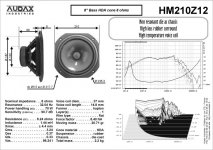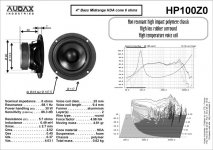Is anyone aware of any attempts to use silica aerogel as a diaphragm material for a speaker cone? I am referring to the stuff NASA uses for thermal insulation and for collecting cosmic dust particles.
This material is the lightest known solid, with a density of about 2 mg/cc. (Air=1.2, Water=1000, Magnesium=1738.) It is very strong and rigid up to a certain load, at which point it deforms reversibly. With progressively higher loads it deforms irreversibly, then shatters. Additionally, it is an excellent acoustic insulator.
Of course, one major drawback is its very high cost.
NOTE: Audax makes some drivers that it calls "Aerogel." But this material appears to be an acrylic foam impregnated with carbon and Kevlar fibers, and is not much lighter in weight than other cone materials. It does not appear to be similar to silica aerogel.
Here is more info on silica aerogel:
http://stardust.jpl.nasa.gov/aerogel_factsheet.pdf
Any comments?
This material is the lightest known solid, with a density of about 2 mg/cc. (Air=1.2, Water=1000, Magnesium=1738.) It is very strong and rigid up to a certain load, at which point it deforms reversibly. With progressively higher loads it deforms irreversibly, then shatters. Additionally, it is an excellent acoustic insulator.
Of course, one major drawback is its very high cost.
NOTE: Audax makes some drivers that it calls "Aerogel." But this material appears to be an acrylic foam impregnated with carbon and Kevlar fibers, and is not much lighter in weight than other cone materials. It does not appear to be similar to silica aerogel.
Here is more info on silica aerogel:
http://stardust.jpl.nasa.gov/aerogel_factsheet.pdf
Any comments?
I am not aware of any or uses of or attemps to use the material in this application, but I think it is a great idea.
I don't know present state of the art, but the aerogels I worked with a few years back were much too delicate to be used in speaker cones.
Do you know if Audax's cones used a syntactic foam, i.e., bubbles added as hollow microspheres?
Do you know if Audax's cones used a syntactic foam, i.e., bubbles added as hollow microspheres?
Not as silly as you think. I've got a cat-damaged quad of HM170Z0 (sob! those were fabulous drivers) stuck away, just in case I could think of something to do with the perfectly good frames, magnets, and coils...
I've got a cat-damaged quad of HM170Z0's



I'm using a pair of those in my main speakers with SS 9500's, it's such a shame Audax doesn't make them anymore, wonderful driver. They have some of the clearest, open and most detailed mid-range I've ever heard 😎
Hi Ric,
what x-o are you using between the Audax and SS? I bought a pair of SS tweeters on ebay to go with my HM170Z18s (currrently paired with SEAS tweeters in an IPL A3) but realised too late that I had bought 38mm 8513 mid-tweeters rather than standard tweeters (can't complain, price was good). I thought series x-o would be promising with this combination but haven't got around to trying it yet.
Ian
what x-o are you using between the Audax and SS? I bought a pair of SS tweeters on ebay to go with my HM170Z18s (currrently paired with SEAS tweeters in an IPL A3) but realised too late that I had bought 38mm 8513 mid-tweeters rather than standard tweeters (can't complain, price was good). I thought series x-o would be promising with this combination but haven't got around to trying it yet.
Ian
Hi Ian 🙂
I've used the lowpass from Vance Dickason's A651 design...
http://www.rjadcenko.com/hi-fi/Audax/a651.htm
I've tried various configurations but I always end up going back to this design.
The highpass is 3rd order with an RC impedance compensation network I came up with using speaker workshop + measurements 😎
Both filters give a 4th order LR curve meeting at 3kHz.
I've used the lowpass from Vance Dickason's A651 design...
http://www.rjadcenko.com/hi-fi/Audax/a651.htm
I've tried various configurations but I always end up going back to this design.
The highpass is 3rd order with an RC impedance compensation network I came up with using speaker workshop + measurements 😎
Both filters give a 4th order LR curve meeting at 3kHz.
SY: Silica aerogel is fragile, but there is a cool photo of a brick sitting on a faily thin slab of it, so it can't be all that delicate. It can be further strengthened by doping with carbon, discussed in the factsheet link.
I could only find a brief description of Audax's "Aerogel" material on Green Mountain Audio's website:
http://www.greenmountainaudio.com/Speakers/Continuum 3/Specifications.htm
It is described under "Midrange" for their Continuum speaker.
Audax's own website does not offer any details about its "Aerogel," at least none that I could decipher with my knowledge of the French language, which is currently limited to "oui" and "bordeaux."
454Casull: Yes, it would look funny compared to other cones. Just as a wild guess, it might be a centimeter thick, but it might still be lighter than a paper, plastic, or metal cone. After I drink some more wine, maybe I will calculate the volume and weight of a 4, 6, 8, 10, and 12 inch diameter cone of 1 cm thick aerogel at 2 mg/cc density. Unless someone else wants to do it for me. 😀
Actually, 2 mg/cc is the lowest density achieved so far. More typical silica aerogels are up to 80 mg/cc.
I could only find a brief description of Audax's "Aerogel" material on Green Mountain Audio's website:
http://www.greenmountainaudio.com/Speakers/Continuum 3/Specifications.htm
It is described under "Midrange" for their Continuum speaker.
Audax's own website does not offer any details about its "Aerogel," at least none that I could decipher with my knowledge of the French language, which is currently limited to "oui" and "bordeaux."
454Casull: Yes, it would look funny compared to other cones. Just as a wild guess, it might be a centimeter thick, but it might still be lighter than a paper, plastic, or metal cone. After I drink some more wine, maybe I will calculate the volume and weight of a 4, 6, 8, 10, and 12 inch diameter cone of 1 cm thick aerogel at 2 mg/cc density. Unless someone else wants to do it for me. 😀
Actually, 2 mg/cc is the lowest density achieved so far. More typical silica aerogels are up to 80 mg/cc.
I have contacted the two (that I could Google) commercial distributors of the substance, asking about the speaker cone potential. They wouldn't even bother responding (yup, used company letterhead) 🙁
Maybe it's not so much manufacturer's won't use it, as they can't get it?
Maybe it's not so much manufacturer's won't use it, as they can't get it?
I did some rough calculations, assuming a cone-shaped diaphragm 1 cm thick with a diameter-to-depth ratio of 4:1.
Assuming aerogel density of 2.0 mg/cc, the masses of a 4, 8, and 12 inch diaphragm would be 0.037 g, 0.154 g, and 0.352 g, respectively. For comparison, typical moving masses of paper cones are 4 g, 33 g, and 75 g, respectively.
I am making many wild assumptions here. For example, I am using an arbitrary 1 cm aerogel thickness for all 3 cone sizes; I am not including the other things that make up moving mass; and I am using the lowest reported density of aerogel. Most aerogels are heavier.
But you get the idea. We are talking about an incredibly lightweight material here. Surely there must be some audio DIY'ers in NASA who could fabricate a few prototypes for testing? 😎
Assuming aerogel density of 2.0 mg/cc, the masses of a 4, 8, and 12 inch diaphragm would be 0.037 g, 0.154 g, and 0.352 g, respectively. For comparison, typical moving masses of paper cones are 4 g, 33 g, and 75 g, respectively.
I am making many wild assumptions here. For example, I am using an arbitrary 1 cm aerogel thickness for all 3 cone sizes; I am not including the other things that make up moving mass; and I am using the lowest reported density of aerogel. Most aerogels are heavier.
But you get the idea. We are talking about an incredibly lightweight material here. Surely there must be some audio DIY'ers in NASA who could fabricate a few prototypes for testing? 😎
You also need to consider breakup. And perhaps for aerogel, it might actually "break up"! 😉
*rimshot*
*rimshot*
I dont know the difference between NASA aerogel and AUDAX aerogel.
What i really know is the performance of my HM210Z12 drivers.
Awesome! The best mids i heve ever heard. Not to mention the detail in drums, or female voices.
All the aerogel drivers had a very good freq. response with no peaks, with a smooth roll off. just take a look
What i really know is the performance of my HM210Z12 drivers.
Awesome! The best mids i heve ever heard. Not to mention the detail in drums, or female voices.
All the aerogel drivers had a very good freq. response with no peaks, with a smooth roll off. just take a look
Attachments
YES they DO!
The room is 45 s.meters, so 2x 6,5inch per speaker, seamed too small to me.
So i used the 210's
By the way, all the aerogels had great mids and bass. Even the cheap series (HPxxx i think) with the plastic frame.
I am using these for my PC
The room is 45 s.meters, so 2x 6,5inch per speaker, seamed too small to me.
So i used the 210's
By the way, all the aerogels had great mids and bass. Even the cheap series (HPxxx i think) with the plastic frame.
I am using these for my PC
Attachments
more than one 'type' of Aerogel-
http://en.wikipedia.org/wiki/Aerogel
Aerogel-
does the name suggest 'high tek shaving cream'?
http://en.wikipedia.org/wiki/Aerogel
Aerogel-
does the name suggest 'high tek shaving cream'?
I have contacted the two (that I could Google) commercial distributors of the substance, asking about the speaker cone potential. They wouldn't even bother responding (yup, used company letterhead) 🙁
Maybe it's not so much manufacturer's won't use it, as they can't get it?
Apparently people have been homebrewing the stuff...
MAKE | Homemade Silica Aerogel
Since there is not a better description....
I also have a quad of HM170Z18's...
I remember reading that it's a 'glass-fiber lattice impregnated with a space-age polymer gel' that Audax (now ACC) use(s/d) in it's aerogel drivers.
It's a great thing that some of these are being reintroduced by ACC.
Wonderful drivers...
Wolf
I also have a quad of HM170Z18's...
I remember reading that it's a 'glass-fiber lattice impregnated with a space-age polymer gel' that Audax (now ACC) use(s/d) in it's aerogel drivers.
It's a great thing that some of these are being reintroduced by ACC.
Wonderful drivers...
Wolf
- Home
- Loudspeakers
- Multi-Way
- Aerogel cones?


